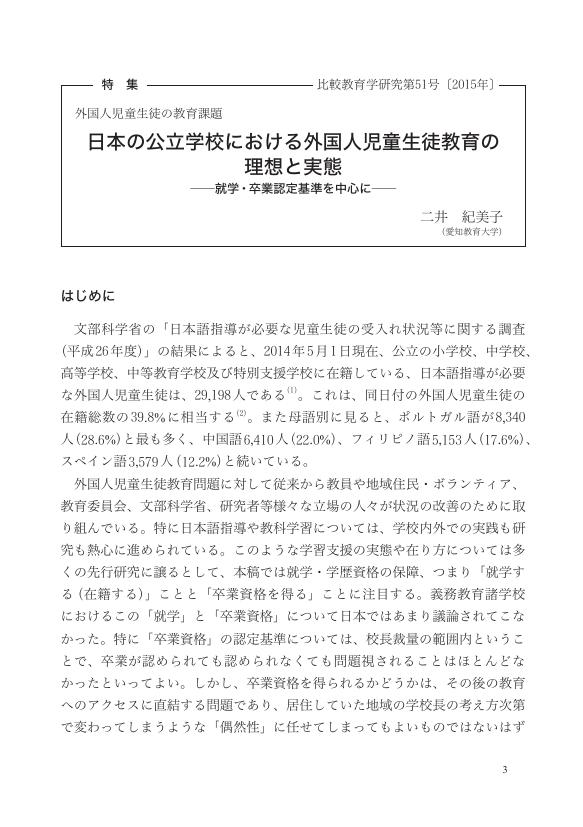- 著者
- 藤井 穂高
- 出版者
- 日本比較教育学会
- 雑誌
- 比較教育学研究 (ISSN:09166785)
- 巻号頁・発行日
- vol.2001, no.27, pp.159-177, 2001
In this article I will try to clarify the logic of the Amendment of the Compulsory Education Act of 1998. In this year an Act to reinforce the control of compulsory education was adopted unanimously in the Parliament. By this act, control of compulsory education in a family setting was reinforced. In France freedom of education has been respected since the formation of the national education system. Why should compulsory education be reinforced in a country which emphasizes freedom of education? This is the fundamental problem to clarify in this article.
- 著者
- 阿部 洋 蔭山 雅博 稲葉 継雄
- 出版者
- 日本比較教育学会
- 雑誌
- 日本比較教育学会紀要 (ISSN:02871106)
- 巻号頁・発行日
- vol.1982, no.8, pp.51-58, 1982
- 著者
- タスタンベコワ クアニシ
- 出版者
- 日本比較教育学会
- 雑誌
- 比較教育学研究 (ISSN:09166785)
- 巻号頁・発行日
- vol.2007, no.35, pp.33-48, 2007
- 被引用文献数
- 1
1 0 0 0 OA マラウイにおける孤児の生活と就学 ―中等教育の就学継続にかかる事例―
- 著者
- 日下部 光
- 出版者
- 日本比較教育学会
- 雑誌
- 比較教育学研究 (ISSN:09166785)
- 巻号頁・発行日
- vol.2015, no.51, pp.106-128, 2015 (Released:2020-08-15)
サブサハラ・アフリカ地域(以下、アフリカ)の孤児数は約5,000万人であり、アフリカにおける子どもの総数に占める割合は約12%である。アフリカの孤児の就学に関する研究では、貧困やHIVエイズの蔓延と不就学の要因に関する分析が重点的に行われてきた。一方で、孤児を含む個人の能力に焦点を当て、困難や脅威に対応する能力と不就学の要因をミクロな視点から分析する必要がある。その理由として、同じ困難や脅威に直面しても、多くの孤児は就学継続を実現していることが挙げられる。 本研究の対象国であるマラウイは、世界最貧国の一つであり、かつ年間のエイズ死亡者数4.8万人、孤児数79万人のHIV高感染国である。孤児の割合は、初等教育において11%、中等教育では19%に達している。無償の初等教育に対し、中等教育は有償にもかかわらず、多くの孤児が中等教育への就学継続を実現しており、本研究ではこの点に着目する。 本研究の目的は、マラウイの中等学校の孤児を対象に、①孤児自身やその親族の就学継続を可能にする取り組み、および②中等学校における就学支援の実践に対する事例分析をもとに、孤児やその親族、教師の視点から、孤児の生活と就学の実態を明らかにすることである。現地調査は、2014年9月にマラウイ南部ゾンバ地区において、中等学校の孤児生徒(33名)、教師(18名)を対象に、ライフストーリー・インタビューを実施した。 孤児の中には、親の死や生活の困窮など複層的に困難な状況に置かれても、中等学校進学後、学費の工面や生活維持を目的とする収入創出活動を通して、就学継続を可能にしていた。しかし、孤児の努力だけでは就学継続が厳しい場面もある。そのため、政府やNGOの奨学金プログラム、学校レベルでは学費の納入猶予や分納以外に、校長裁量で半額免除や未納の見逃し、教師による緊急時の支援等が展開されている。 孤児は厳しい生活環境の中で、時には、制服を洗濯するための一つの石鹸が確保できないことも、孤児の就学継続に影響を与えている。そのような困難な状況に置かれながらも、孤児自身の取り組みに加え、親族や教師といった周囲の関係者からの支援、政府やNGOの奨学金支援や校長裁量による学校側の柔軟な対応など、個人を取り巻く環境や人々の繋がりにより、孤児の就学継続が支えられている実態が明らかとなった。
1 0 0 0 中国における少数民族高等教育政策
- 著者
- 小川 佳万
- 出版者
- 日本比較教育学会
- 雑誌
- 比較教育学研究 (ISSN:09166785)
- 巻号頁・発行日
- vol.1994, no.20, pp.93-104,215, 1994
- 被引用文献数
- 1
This paper deals with Chinese higher education policies for minorities focusing on the mechanisms of “preference” and “control.” The findings are as follows: First, the Chinese government established “Institutes of Nationalities”(Minzu Xueyuan) for the training of minorities' cadres. These “Institutes of Nationalities” originated with “Liberation Area-Type Colleges”, which put an emphasis on political-ideological education.<BR>Second, Chinese higher education policies for minorities are characterized as “preference.” Many of preferential policies have been instituted thus far, such as special treatments for minorities in the admission procedures and campus life of the “Institutes of Nationalities.”
1 0 0 0 OA ケニアの学校におけるいじめと体罰
- 著者
- 澤村 信英
- 出版者
- 日本比較教育学会
- 雑誌
- 比較教育学研究 (ISSN:09166785)
- 巻号頁・発行日
- vol.2013, no.47, pp.63-75, 2013 (Released:2020-05-01)
1 0 0 0 OA アメリカにおけるキャラクター・エデュケーションの動向 特集 子どもの危機と教育の対応
- 著者
- 岩佐 信道
- 出版者
- 日本比較教育学会
- 雑誌
- 比較教育学研究 (ISSN:09166785)
- 巻号頁・発行日
- vol.2000, no.26, pp.18-28, 2000-07-05 (Released:2011-01-27)
- 参考文献数
- 22
- 著者
- 米澤 彰純
- 出版者
- 日本比較教育学会
- 雑誌
- 比較教育学研究 (ISSN:09166785)
- 巻号頁・発行日
- vol.2014, no.48, pp.156, 2014
- 著者
- 小松 太郎
- 出版者
- 日本比較教育学会
- 雑誌
- 比較教育学研究 (ISSN:09166785)
- 巻号頁・発行日
- vol.2017, no.55, pp.59-71, 2017
1 0 0 0 渡辺雅子著「納得の構造-日米初等教育に見る思考表現のスタイル-」
- 著者
- 恒吉 僚子
- 出版者
- 日本比較教育学会
- 雑誌
- 比較教育学研究 (ISSN:09166785)
- 巻号頁・発行日
- vol.2005, no.31, pp.281-283, 2005
- 著者
- 遠藤 克弥
- 出版者
- 日本比較教育学会
- 雑誌
- 日本比較教育学会紀要 (ISSN:02871106)
- 巻号頁・発行日
- vol.1981, no.7, pp.33-38, 1981-03-31 (Released:2010-08-06)
- 参考文献数
- 27
- 著者
- タスタンベコワ クアニシ
- 出版者
- 日本比較教育学会
- 雑誌
- 比較教育学研究 (ISSN:09166785)
- 巻号頁・発行日
- vol.2007, no.35, pp.33-48, 2007-06-25 (Released:2011-01-27)
- 被引用文献数
- 1
1 0 0 0 OA 日本の公立学校における外国人児童生徒教育の理想と実態 ―就学・卒業認定基準を中心に―
- 著者
- 二井 紀美子
- 出版者
- 日本比較教育学会
- 雑誌
- 比較教育学研究 (ISSN:09166785)
- 巻号頁・発行日
- vol.2015, no.51, pp.3-14, 2015 (Released:2020-08-15)
1 0 0 0 フランス多民族国家における「統合」社会像の矛盾
- 著者
- 池田 賢一
- 出版者
- 日本比較教育学会
- 雑誌
- 比較教育学研究 (ISSN:09166785)
- 巻号頁・発行日
- vol.1998, no.24, pp.86-100, 1998
In France the educational policy for children of immigrants and foreigners began to be formed in the 1970s.That was aimed to adapt them to French society and school through their learning French.In the 1980s the policy for ‘right to be different’ attracted an attention of the public in the dominant political power of the Socialist Party.But for many foreign children born in France the policy of ‘adaptation’ and ‘admitting difference’ is not necessarily relevant.Presently the policy of ‘integration’ is being adopted to make the French society through participation and solidality of all people.
- 著者
- 江原 裕美
- 出版者
- 日本比較教育学会
- 雑誌
- 比較教育学研究 (ISSN:09166785)
- 巻号頁・発行日
- vol.2007, no.35, pp.65-83, 2007-06-25 (Released:2011-01-27)
1 0 0 0 OA 1988年イギリス教育改革法の主要点と問題点
- 著者
- 宮腰 英一
- 出版者
- 日本比較教育学会
- 雑誌
- 比較教育学研究 (ISSN:09166785)
- 巻号頁・発行日
- vol.2002, no.28, pp.28-40, 2002-06-30 (Released:2011-01-27)
1 0 0 0 OA 中国における二言語教育と民族的アイデンティティの形成 民族文化共生の視点から
- 著者
- 張 瓊華
- 出版者
- 日本比較教育学会
- 雑誌
- 比較教育学研究 (ISSN:09166785)
- 巻号頁・発行日
- vol.1998, no.24, pp.180-197, 1998-06-30 (Released:2011-01-27)
Bilingual education has been adopted in school education in order to carry outan equality policy for ethnic groups in China. There are two modes of bilingualeducation in China. One is using the ethnic language as a teaching language while Chinese is taught as a subject. The other is where Chinese is used as a teachinglanguage and the ethnic language is taught as a subject. Bilingual education has beenregarded as useful in promoting a common language and forming common culture, andalso helpful in maintaining ethnic language and culture. Does it really have such a keyrole? It is very interesting to study the function of bilingual education in formation ofethnic identities in China from the perspective of coexistence of multiethnic cultures.
1 0 0 0 大学における養成を中心として
- 著者
- 内海 巌
- 出版者
- 日本比較教育学会
- 雑誌
- 日本比較教育学会紀要 (ISSN:02871106)
- 巻号頁・発行日
- vol.1977, no.3, pp.16-20, 1977
1 0 0 0 国際理解教育の現状と基本的課題
- 著者
- 内海 巌
- 出版者
- 日本比較教育学会
- 雑誌
- 日本比較教育学会紀要 (ISSN:02871106)
- 巻号頁・発行日
- vol.1978, no.4, pp.1-4, 1978







